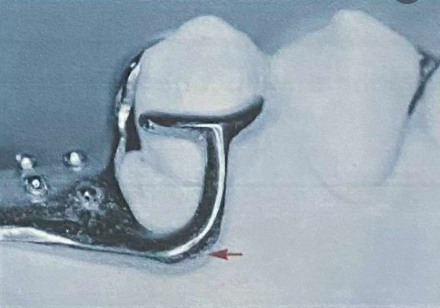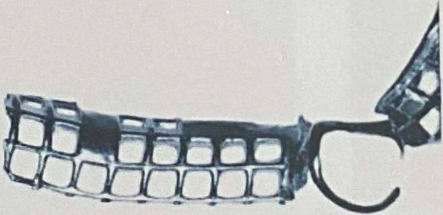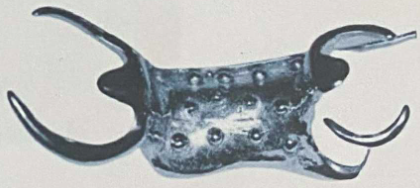CHAPTER 5: MINOR CONNECTORS
1/34
There's no tags or description
Looks like no tags are added yet.
Name | Mastery | Learn | Test | Matching | Spaced |
|---|
No study sessions yet.
35 Terms
Minor connectors
are the connecting link between the major connector or base of a removable partial denture and other prosthesis components
They may be continuous with some other part of the denture, such as an occlusal rest at one end of a linguoplate
The portion of a partial denture framework that supports the clasp and the occlusal rest
Those portions of a removable partial denture frame- work that retain the denture bases
When dental implants are placed, modifications can be required in the denture base retaining minor connector
contacts the guiding plane surfaces of the abutment teeth, whether as a connected part of a direct retainer assembly or as a separate entity
rigidity is an essential characteristics of this connector
the broad distribution of forces prevents any one tooth or any portion of an edentulous ridge from bearing a destructive amount of stress
Modifications for anterior implants to enhance retention
must consider retentive device bulk and connection requirements
For implants placed more distal for support purposes
space for embedding an attachment housing within the denture base is required
2 functions of minor connectors
serves as a connecting link between the major connector or the base of a rpd and the other components
transfers occlusal forces from prosthesis to abutment and abutment to prosthesis
prosthesis-to-abutment function of the minor connector
Transfers functional stress to the abutment teeth
Occlusal forces applied to the artificial teeth are transmitted through the base to the underlying ridge tissue if that base is primarily tissue supported
Occlusal forces applied to the artificial teeth are also transferred to abutment teeth via occlusal rests.
Minor connectors from a rigid major connector facilitate this transfer of functional stress throughout the dental arch
abutment-to-prosthesis function of the minor connector
Transfers the effects of the retainers, rests, and stabilizing components throughout the prosthesis
Thus forces applied on one portion of the denture may be resisted by other components placed elsewhere in the arch for that purpose.
A stabilizing component on one side of the arch may be placed to resist horizontal forces that originate on the opposite side.
This is possible only because of the transferring effect of the minor connector, which supports that stabilizing component, and the rigid- ity of the major connector.
form and location of minor connector
must be rigid and not objectionable to transfer functional stresses to supporting teeth and tissue
should be located in an embrasure and not on a convex surface, least noticeable to the tongue, and conform to the interdental embrasure
passing vertically from the major connector so that the gingival crossing is abrupt and covers as little of the gingival tissue as possible
should be thickest toward the lingual surface, tapering toward the contact area
provides intimate tissue contact, preventing food from dislodging the prosthesis
The deepest part of the interdental embrasure should have been blocked out to avoid interference during placement and removal, and to avoid any wedging effect on the contacted teeth.
when it contacts tooth surfaces on either side of the embrasure, it should be tapered to the teeth to avoid sharp angles and trap food, hinder tongue movement
must be wide enough for optimal use of guiding plane
Tapered to tooth below clasp origin — when forming a clasp arm
Tapered to knife-edge full length of buccal aspect — if no clasp arm is formed
Minor Connector Guidelines
(1) WHEN A MINOR CONNECTOR CONTACTS TOOTH SURFACE ON EITHER SIDE OF THE EMBRASURE IN WHICH IT LIES, IT SHOULD BE TAPERED TO THE TEETH, THIS AVOIDS SHARP ANGLES WHICH COULD HINDER TONGUE MOVEMENT
(2) CONTACTS THE AXIAL SURFACE OF AN ABUTMENT THAT SHOULD NOT BE LOCATED ON A CONVEX SURFACE
(3) LOÇATED IN AN EMBRASURE WHERE IT WILL BE LEAST NOTICEABLE TO THE TONGUE
(4) PASSING VERTICALLY FROM THE MAJOR CONNECTOR SO THAT IHE GINGIVAL CROSSING IS ABRUPT AND COVERS AS LITTLE OF THE GINGIVAL TISSUE AS POSSIBLE
(5) IN AN EMBRASURE SPACE, THE MINOR CONNECTOR IS TAPERED TO THE TOOTH TO AVOID BULK AND TO ACCOMMODATE THE TONGUE
(6) SUFFICIENT BULK TO BE RIGID YET THE BULK OF THE MINOR CONNECTOR SHOULD NOT BE OBJECTIONABLE
(7) A MINOR CONNECTOR THAT CONTACTS THE GUIDING PLANE CAN BE CONNECTED PART OF A DIRECT RETAINER ASSEMBLY OR AS A SEPARATE ENTITY ALONE
Modification of Removable Partial Denture Minor Connector
Proposed for maxillary arch application
Minor connector located in lingual surface of maxillary abutment tooth
Reduces gingival tissue coverage
Enhances partial denture guidance during insertion and removal
Increases stabilization against horizontal and rotational forces
Location may encroach on tongue space, creating food entrapment space
Requires careful application.
Artificial Tooth Placement and Minor Connector Design
The majority of the minor connector should be towards the lingual aspect of the abutment tooth to ensure sufficient bulk without affecting the placement of the artificial tooth
The artificial tooth should contact the abutment tooth with only a thin layer of metal intervening buccally
The minor connector should lie in the interdental embrasure, similar to between two natural teeth
Minor connectors should be completely embedded within the denture base, with strong butt-type joints without appreciable bulk
Angles formed at connector junctions should not exceed 90 degrees for the strongest mechanical connection
An open latticework or ladder design is preferred, made using preformed wax strips
Minor connectors for mandibular distal extension base should extend posteriorly about two-thirds the length of the edentulous ridge and have elements on both lingual and buccal surfaces
A means to attach acrylic-resin individualized trays to the mandibular framework should be arranged when the framework pattern is being developed
In an embrasure space, the minor connector is tapered to the tooth to avoid bulk and to accommodate the tongue.
minor connector that contacts the guiding plane
Part of a clasp assembly, either separate or connected to the lingual stabilizing portion
Contacts the guiding plane about half the distance between adjacent buccal and lingual cusps of the abutment tooth
Extends gingivally, contacting an area of the abutment from the marginal ridge to two-thirds the length of the enamel crown
Viewed from above, it is triangular, with the apex located buccally and the base lingually
Less interference with adjacent artificial tooth arrangement.
Tissue Stops
are integral parts of minor connectors designed for retention of acrylic-resin bases
They pro- vide stability to the framework during the stages of transfer and processing.
They prevent distortion of the framework during acrylic- resin processing procedures
can engage buccal and lingual slopes of the residual ridge for stabil- ity
Altered cast impressions often require tissue stops to be augmented.
Autopolymerizing acrylic resin can be used to achieve this
Minor connector retains acrylic-resin denture base
Distal to terminal abutment, it establishes a definitive finishing index tissue stop for the acrylic-resin base.
FUNCTION(S of tissue stop
(1) PROVIDE STABILITY TO THE FRAMEWORK DURING THE STAGES OF TRANSFER AND PROCESSING
(2) PREVENTING DISTORTION OF THE FRAMEWORK DURING ACRYLIC-RESIN PROCESSING PROCEDURE
finishing Index Tissue Stop
Similar to a tissue stop but serves a different function.
Located distal to the terminal abutment and is a continuation of the minor connector contacting the guiding plane.
Purpose is to establish a definitive finishing index tissue stop for the acrylic resin base after processing
Finishing Line
The ideal location is at the junction of major and minor connectors at palatal finishing lines should be located 2mm medial from an imaginary line that would contact the lingual surfaces missing posterior teeth
should not be greater than 90 degrees, somewhat undercut
The medial extent of the minor connector depends on the lateral extent of the major palatal connector
its location should be based on restoration of the natural palatal shape, considering the location of replacement teeth
Equal consideration should be given to the junction of minor connectors and bar-type direct retainer arms
These junctions are 90-degree butt-type joints and should follow base contour and clasp length guidelines.
consequence when finishing line is located too far medially
the natural contour of the palate will be altered by the thickness of the junction and the acrylic resin supporting the artificial teeth
consequence when finishing line is located too far buccally
it will be most difficult to create a natural contour of the acrylic resin on the lingual surface of the artificial teeth
Tissue Reaction to Metallic Parts of Removable Partial Dentures
Controversy surrounds tissue reactions to partial denture coverage, especially in marginal gingiva and broad tissue contact areas
Pressure from lack of support, inadequate hygiene measures, and prolonged prosthesis use can cause tissue reactions
Settling of the denture can result from loss of tooth and/or tissue support, causing pressure elsewhere in the arch
Excessive pressure must be avoided when oral tissue must be covered or crossed by partial denture elements
Lack of hygiene measures can result in tissue reactions due to accumulation of food debris and bacteria
Maintaining cleanliness of the tissue surface of the prosthesis is another hygiene concern
Prosthesis wear can exacerbate untoward tissue reaction, leading to inflammation and breakdown of the epithelial barrier
Patients often neglect to remove partial dentures often, leading to changes in living tissues
Clinical experience shows that tissue coverage is not detrimental to oral tissue health when pressure, cleanliness, and time are controlled
components of removable partial denture
directly attached to the major connector
indirectly attached to the major connector
directly attached to the major connector
the components dont need a connecting link in order to be attached towards the major connector
ex: metallic denture bases and minor connector
indirectly attached to the major connector
these components need a connector in order to be attached towards the major connector
ex: rest, direct retainer, indirect retainer, acrylic denture bases
OPEN LATTICE FRAMEWORK
PORTION OF DENTRE FRAMEWORK BY WHICH ACRYLIC RESIN DENTURE BASES ARE ATTACHED
MADE BY USING 12 GAUGE HALF ROUND AND 18 GAUGE ROUND WAX STRIPS
THE LATTICE FRAMEWORK'S THICKNESS IS ELEVATED BY 1.5MM EACH CONSUMING AN INTER RIDGE DISTANCE OF 3.0MM. T
HE MANDIBULAR'S RETROMOLAR PAD IS ALSO AN ELEVATED LANDMARK AND IF THE FRAMEWORK COVERS THIS, IT WILL APPROXIMATE THE MAXILLARY TUBEROSITY AND SPACE BECOMES TOO LIMITER FOR THE PLACEMENT OF MOLAR PONTICS.
THE ELEVATED PART OF THE RETROMOLAR PAD AND THE ASCENDING RADIUS SHOULD BE AVOIDED TO ALLOW PROPER PLACEMENT OF MOLAR PONTICS
MAXILLARY OPEN LATTICE ON DISTAL EXTENSION
SHOULD EXTEND THE ENTIrE LENGTH OF THE RESIDUAL RIDGE AND SHOULD BE OF A LADDERLIKE AND LOOP DESIGN
MANDIBULAR OPEN LATTICE ON DISTAL EXTENSION
THE MINOR CONNECTOR FOR THE MANDIBULAR DISTAL EXTENSION BASE SHOULD EXTEND POSTERIORlY ABOUT 2/3RD THE LENGTH OF THE EDENTULOUS RIDGE
Indications of Mesh type
LIMITED OCCLUSOCERVICAL CLEARANCE FROM THE OPPOSING DENTITION
SUPRAERUPTED OPPOSING TOOTH
DIFFICULTY IN PLACING THE PONTICS TO SATISFY IDEAL OCCLUSION FOR THE PATIENT
consequence of bending or deformation of a minor connector
may result in stress concentration and damage to the supporting teeth and soft tissues
categories of minor connector
minor connectors that join clasp assemblies to major connectors
minor connectors that join indirect retainers or auxiliary rests to major connectors
minor connectors that join denture bases to major connectors
minor connectors that serve as approach arms for vertical projection / bar-type clasp
minor connectors that join clasp assemblies to major connectors
Connects the clasp (retentive + reciprocal parts) to the major connector.
Used whenever a direct retainer (clasp) is needed to hold the denture in place.

minor connectors that join indirect retainers or auxiliary rests to major connectors
Transfers forces from indirect retainers / auxiliary rests to the major connector
Used when indirect retention or extra support (auxiliary rests) is needed to prevent denture rotation

minor connectors that join denture bases to major connectors
Provides attachment for the denture base and artificial teeth to the major connector
Used in tooth-supported and distal extension RPDs to carry acrylic base and teeth.

minor connectors that serve as approach arms for vertical projection / bar-type clasp
Acts as the pathway or arm that brings the bar clasp from the gingival direction to engage the undercut.
Used specifically with bar clasps (I-bar, T-bar, modified T-bar)

lattice framework on MX
a distal extension base must extend into the pterygomaxillary notch
this is to provide appropriate mechanical support for the denture base, the minor connector should extend beyond the most prominent portion of the tuberosity (arrow)

lattice framework on MN
a distal extension base must cover the retromolar pad
this is to provide appropriate mechanical support, the minor connector should extend be two-thirds the length of the edentulous ridge

mesh construction
Provides a lattice or grid where acrylic resin can lock in
Most common method to attach denture base and artificial teeth.

bead, nailhead, or wire construction
Provides mechanical retention for acrylic by beads, nailhead-shaped projections, or wires embedded in resin.
Used when space is limited or when mesh can’t be used.
